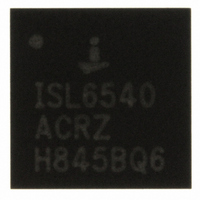ISL6252HRZ Intersil, ISL6252HRZ Datasheet - Page 15

ISL6252HRZ
Manufacturer Part Number
ISL6252HRZ
Description
IC BATTERY CHARGER CTRLR 28-QFN
Manufacturer
Intersil
Datasheet
1.ISL6252HAZ.pdf
(25 pages)
Specifications of ISL6252HRZ
Function
Charge Management
Battery Type
Lithium-Ion (Li-Ion), Lithium-Polymer (Li-Pol)
Voltage - Supply
7 V ~ 25 V
Operating Temperature
-10°C ~ 100°C
Mounting Type
Surface Mount
Package / Case
28-VFQFN Exposed Pad
Lead Free Status / RoHS Status
Lead free / RoHS Compliant
Current Measurement
Use ICM to monitor the input current being sensed across
CSIP and CSIN. The output voltage range is 0V to 2.5V. The
voltage of ICM is proportional to the voltage drop across
CSIP and CSIN, and is given by Equation 14:
where I
ICM has ±3% accuracy. It is recommended to have an RC
filter at the ICM output for minimizing the switching noise.
LDO Regulator
VDD provides a 5.0V supply voltage from the internal LDO
regulator from DCIN and can deliver up to 30mA of current.
The MOSFET drivers are powered by VDDP, which must be
connected to VDDP as shown in Figure 2. VDDP connects
to VDD through an external low pass filter. Bypass VDDP
and VDD with a 1µF capacitor.
Shutdown
The ISL6252 features a low-power shutdown mode. Driving
EN low shuts down the ISL6252. In shutdown, the DC/DC
converter is disabled, and VCOMP and ICOMP are pulled to
ground. The ICM, ACPRN output continue to function.
EN can be driven by a thermistor to allow automatic
shutdown of the ISL6252 when the battery pack is hot. Often
a NTC thermistor is included inside the battery pack to
measure its temperature. When connected to the charger,
the thermistor forms a voltage divider with a resistive pull-up
to the VREF. The threshold voltage of EN is 1.0V with 60mV
hysteresis. The thermistor can be selected to have a
resistance vs temperature characteristic that abruptly
decreases above a critical temperature. This arrangement
automatically shuts down the ISL6252 when the battery pack
is above a critical temperature.
Another method for inhibiting charging is to force CHLIM
below 85mV (typ).
Short Circuit Protection and 0V Battery Charging
Since the battery charger will regulate the charge current to
the limit set by CHLIM, it automatically has short circuit
protection and is able to provide the charge current to wake
up an extremely discharged battery.
Over-Temperature Protection
If the die temp exceeds +150°C, it stops charging. Once the
die temp drops below +125°C, charging will start up again.
Overvoltage Protection
ISL6252 has an Overvoltage Protection circuit that limits the
output voltage when the battery is removed or disconnected
by a pulse charging circuit. If CSON exceeds the output
voltage set point by more than V
pulls VCOMP down and turns off both upper and lower FETs
of the buck, as in Figure 17. The trip point for Overvoltage
ICM
=
INPUT
19.9 I
•
INPUT
is the DC current drawn from the AC adapter.
•
R
2
15
OVP
an internal comparator
ISL6252, ISL6252A
(EQ. 14)
Protection is always above the nominal output voltage and
can be calculated from Equation 15:
For example, if the CELLS pin is connected to ground
(N
V
V
There is a delay of approximately 400nsec between V
exceeding the OVP trip point and pulling VCOMP, LGATE
and UGATE low.
During normal operation with cells installed, the CSON pin
voltage will be the cell stack voltage. When EN is low and the
cells are removed, this voltage may drop below 100mV. Due
to non-linearities in the OVP comparator at this low input
level, the VCOMP pin may be held low even after EN is
commanded high. If regulation is required in the absence of
cells then a series resistor and diode need to be installed
which inject current into the CSON pin from the V
See R23 and D5 in Figure 3. This will maintain the CSON pin
voltage well within its linear range in the absence of cells,
and will be effectively out of the circuit when the diode is
reversed biased by the cell stack. Resistor values from 10k
to 100k have been found to be effective.
Application Information
The following battery charger design refers to the typical
application circuit in Figure 2, where typical battery
configuration of 4S2P is used. This section describes how to
select the external components including the inductor, input
and output capacitors, switching MOSFETs, and current
sensing resistors.
V
OUT,NOM
OUT,NOM
OVP
CELLS
BATTERY
REMOVAL
VCOMP
PHASE
ICOMP
FIGURE 17. OVERVOLTAGE PROTECTION IN ISL6252
=
= 3) and V
V
OUT NOM
= 12.6V and V
+ 93mV.
,
ADJ
+
N
CELLS
is floating (V
OVP
×
= 12.693V or
⎛
⎝
42.2mV 22.2mV
AND FETS TURN OFF
VCOMP IS PULLED LOW
WHEN V
THE OVP THRESHOLD
CURRENT FLOWS IN THE
LOWER FET BODY DIODE
UNTIL INDUCTOR CURRENT
REACHES ZERO
ADJ
V
OUT
OUT
–
= 1.195V) then
EXCEEDS
August 25, 2010
DD
×
--------------- -
2.39V
V
(EQ. 15)
pin.
ADJ
FN6498.3
OUT
⎞
⎠












